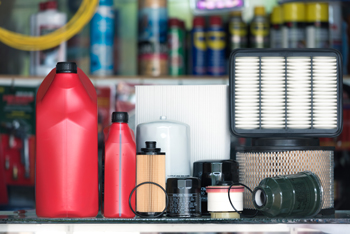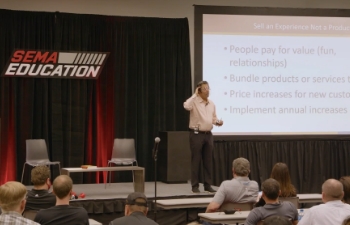SEMA News—October 2019
RETAIL SPOTLIGHT
Brick-and-Mortar Retailing
Four Ways to Play Up Your Advantages
 Far too many automotive stores look alike, so injecting your distinct personality into yours can give you an edge. Survey what others do, then ask what you can do to stand out and create a better experience for customers. |
There’s little doubt that the explosive growth of online sellers has given local retailing a run for its money. Still, while big sellers such as Amazon can be tough competitors, they can’t completely drive traditional brick-and-mortar stores out of business. That’s because local retail outlets have several inherent advantages that the big guys can never match.
“We see far too many brick-and-mortar retailers looking at internet sellers and saying, ‘I can’t do what they do,’” said Tom Shay, principal of Profits Plus Solutions, a small-business advisory firm based in St. Petersburg, Florida. “What we don’t see enough of is retailers looking at the other side of the equation and asking, ‘What can I do that they can’t or won’t do?’
“The key is making the business something a customer wants to be around. As an example, I read where Starbucks decided to stop selling its products on its website. Others may sell Starbucks products online, but Starbucks will not. Their reason is that they want their customers to experience their stores. That represents a lot of confidence in what their stores look like and how their people perform.
“How confident are aftermarket retailers that a customer would have a great experience in their place? If they aren’t going to try to win customers by having the lower price on an item, then what are they going to do to win the customer?”
According to Shay, the right answers involve recognizing your brick-and-mortar strengths and then playing them up.
 As competition from online sellers continues to tighten, brick-and-mortar stores still boast several advantages, including the ability to directly engage customers. Learning to play up such advantages can help a retailer thrive. |
1. Offer Customers an Experience
First of all, brick-and-mortar stores are still the one place where consumers can see and touch merchandise while getting their questions instantly answered in detail. Despite misconceptions floating around the popular media, research indicates that the desire among consumers to personally investigate and buy products in a retail setting cuts across all demographics, including Millennials. To play up that advantage, a retail owner should make his or her brick-and-mortar outlet stand out as an experience.
According to Shay, a store should have so many touchpoints (sights, sounds, etc.) seamlessly working together that a customer can’t figure out what exactly makes the overall experience inviting—they just know that it is. Just as important, those touchpoints should start presenting themselves long before a customer even walks through the door.
“I recently stopped into an auto-parts store in Arkansas,” Shay related. “The sign they had out front was so faded that you couldn’t read anything on it. Its lights were burnt out, and the metal post was all rusted. That’s the first impression. Tell me about your parking lot. Is it clean? Is it striped? Does it have potholes? Do you have lights in the parking lot and on the front of the building? Fifty-three percent of a customer’s impression of a business comes from when they first see it, not when they get in it. The key is to start selling from where I can first see you, 200–300 yards away.”
He added that owners should ensure that their promotional signage is current and that it doesn’t obscure the goodies inside the windows. Even seemingly minor details make a difference.
“Once you get inside the door, then we’re down to lights, which can move you around the store simply by where they are concentrated,” he said. “If I want to get customers to a corner of a store, all I have to do is add more lights there. Even the music matters. I like country and jazz, but the right kind of music is a lighter jazz—almost an instrumental piece—because it’s not offensive. It’s the least hated music out there.”
Shay also advised another simple way to set your store apart from competitors: Ditch the branded racks.
“Walk into most places, and you’re in nothing but a collection of manufacturer display racks,” he said. “That’s wrong. This is your store. What you’re selling is your personality. If every other store is filled with the same identical racks, how have you shown personality?”
Shay said that it’s fine in the end to get ideas from other retailers, but don’t outright copy them. Instead, ask yourself what those other businesses get right and what they do wrong, then strategize how you can take their ideas and do better. The point is to create innovative touchpoints that differentiate your outlet and the shopping experience it offers from your rivals down the street, since auto-parts stores everywhere tend to look far too similar to begin with.
 Creating kits of items needed to get a job done right is one way to differentiate your store from online sellers. At the very least, employees should learn how to brainstorm related products they can suggest to customers who come in for one or two items. |
2. Strive for Engagement
The ability to engage customers in person is a tremendous advantage, which makes customer service all the more important. You may think you offer great customer service, but Shay suggested that you start by checking your reviews on Yelp and other social media if you truly want an honest appraisal. What you find may surprise you.
“I always ask business owners one question,” he said. “Do you have a class that meets on some regularly scheduled basis in which everyone who works for you comes, participates, and does things like practice selling? If the answer is no, then how do you expect me to believe you really give great customer service? Do you think it just happens? I encourage people to teach everyone who works for them how to do customer service.”
Remember, a parts store can be intimidating for a do-it-yourself customer, especially when the sales people stand behind a counter staring at screens while looking up items and prices.
“You want the customer involved as part of the transaction,” Shay said. “Don’t leave them twiddling their thumbs. Turn the screen sideways, and let the customer look at it with you. Sit them down and talk.”
In fact, take a good hard look at your staff and how they dress. Do they stand out? Are they wearing distinctive clothing proudly branded with your shop’s insignia? Can they be spotted the moment a customer steps into the store? Can they handle several customers at once? No customer should ever have to wait for acknowledgment, let alone go on a search for help.
“When you’re good as a sales person, you can wait on several people at the same time,” Shay said. He also advised that staff take parts from boxes and place them in customers’ hands while demonstrating their features.
“We know that if I can get the product in the customer’s hand, there’s something psychologically that happens to the customer,” he explained. “They begin to own the merchandise.”
Lastly, if an item isn’t in stock, salespeople should check to see when it will arrive and inform the customer. Better yet, take the customer’s contact information and promptly alert him when the product does come in. Supply additional information about the product and its manufacturer to whet the customer’s appetite. Make it worth their time to return and get the item from you. Strive to take customer service to the next level of actual customer engagement.
3. Add Value to Your Sales
Online sellers certainly offer a wide variety of products at competitive prices, but they often display little knowledge of what aftermarket customers truly need for a project. That’s another deficiency that retailers can turn to their advantage.
“There’s so much more that a physical retailer can do as part of the sale to help the customer get the job done right,” Shay explained. “For example, let’s say I’m going to sell you an alternator. I can do it like an online retailer and try to compete on price, which gets ugly. But think about it: What else does the customer need? How about a sample-size tube of dielectric grease, thread locker and new bolts?”
Don’t just suggest those items as upsells. Instead, actually bundle them all into a single kit that ultimately saves the customer time and effort at little, if any, additional cost. Your shoppers will appreciate not only the convenience but also the thinking ahead that you’ve done for them. That adds incalculable value, Shay said.
“What customer is going to go back to somebody’s website and calculate the cost of all those separate items?” he asked. “It’s no longer a comparison of apples to apples. You’re making your sale a different product than what the others have got.”
When it comes to actual upselling, be sure that your people clue customers into special deals and shop promotions, even if there’s no obvious connection to what they originally came in for. Explain the benefits of those deals to the customer. If you’re having a “buy-one-get-one-free” offer on wiper blades, talk up the safety and convenience of always having a spare set on hand. Do it in a spirit of helpfulness. In fact, as part of your staff’s customer-service training (see bullet #2 on p. 294), play a variation on the old hot-potato game. Gather your employees in a circle and pass around a product, giving each one 10 seconds to suggest something else they can offer a customer who came in for that item.
| SEMA Show Retail Seminars | |
| Tom Shay, principal of Profits Plus Solutions, is slated to deliver two “Retail Next” educational programs at the 2019 SEMA Show in Las Vegas. The first, entitled “Competing With the Big Box,” will expand on many of the concepts featured in this article. The second, “A Pricing Strategy; Keys to Stop Discounting,” will look at five unique components of a successful business pricing plan to increase customer count and profits. For details and to register, go to www.SEMAShow.com/education. |
4. Be a Community Hub
Retailers have one final advantage over online sellers: They know their community. Look for local groups doing automotive events and ask how you can participate. Or else organize your own. Send out a weekly e-newsletter reporting your activities and the automotive exploits of your customers. Invite manufacturers to demonstrate new products at customer gatherings several times a year and serve up hot dogs. Those are just a few of the many simple ways you can make your brick-and-mortar store more visible within your locality.
“Even better, come to the SEMA Show and make sure you go to the business seminars,” Shay suggested. “And go around the Show and look. It’s a good investment. When you come to the SEMA Show, you’re the first to see whatever is new.”
Position yourself as a sort of consumer correspondent at the Show for your customers back home. Using social media, share your photos, experiences and first-hand impressions of the latest trends as you walk the Show floor. Invite your followers to share likes and comments on what you’re posting. Doing so will further your reputation as an aftermarket expert, strengthen your customer relationships, and make your store an indispensable hub of your local enthusiast community.








